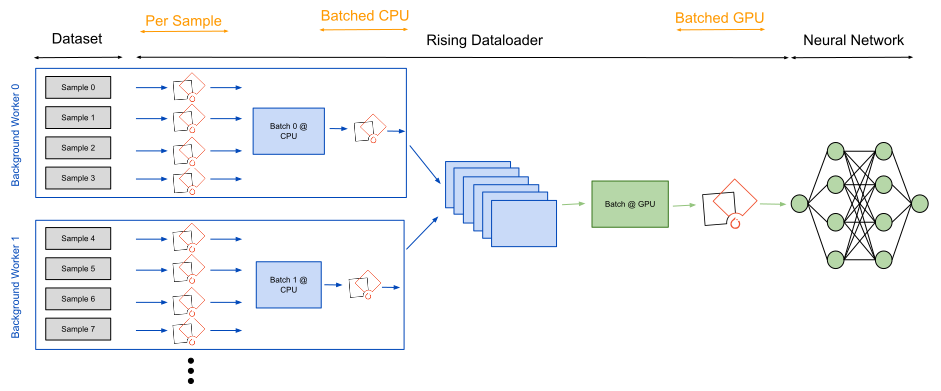What is rising?¶
Rising is a high-performance data loading and augmentation library for 2D and 3D data completely written in PyTorch. Our goal is to provide a seamless integration into the PyTorch Ecosystem without sacrificing usability or features. Multiple examples for different use cases can be found in our tutorial docs e.g. 2D Classification on MedNIST, 3D Segmentation of Hippocampus (Medical Decathlon), Example Transformation Output, Integration of External Frameworks
Installation¶
Pypi Installation
pip install rising
Editable Installation for development
git clone git@github.com:PhoenixDL/rising.git
cd rising
pip install -e .
Running tests inside rising directory (top directory not the package directory)
python -m unittest
Check out our contributing guide for more information or additional help.
What can I do with rising?¶
Rising currently consists out of two main modules:
rising.loading¶
The Dataloader of rising will be your new best friend because it
handles all your transformations and applies them efficiently to the
data either on CPU or GPU. On CPU you can easily switch between
transformations which can only be performed per sample and
transformations which can be applied per batch. In contrast to the
native PyTorch datasets you don’t need to integrate your augmentation
into your dataset. Hence, the only purpose of the dataset is to provide
an interface to access individual data samples. Our DataLoader is a
direct subclass of the PyTorch’s dataloader and handles the batch
assembly and applies the augmentations/transformations to the data.
rising.transforms¶
This module implements many transformations which can be used during training for preprocessing and augmentation. All of them are implemented directly in PyTorch such that gradients can be propagated through the transformations and (optionally) it can be applied on the GPU. Finally, all transforms are implemented for 2D (natural images) and 3D (volumetric) data.
In the future, support for keypoints and other geometric primitives which can be assembled by connected points will be added.
rising MNIST Example with CPU and GPU augmentation¶
rising uses the same Dataset structure as PyTorch and thus we
can just reuse the MNIST dataset from torchvision.
import torchvision
from torchvision.transforms import ToTensor
# define dataset and use to tensor trafo to convert PIL image to tensor
dataset = torchvision.datasets.MNIST('./', train=True, download=True,
transform=ToTensor())
In the next step, the transformations/augmentations need to be defined.
The first transforms converts the Sequence from the torchvision dataset
into a dict for the following rising transform which work on dicts.
At the end, the transforms are compose to one callable transform which
can be passed to the Dataloader.
import rising.transforms as rtr
from rising.loading import DataLoader, default_transform_call
from rising.random import DiscreteParameter, UniformParameter
# define transformations
transforms = [
rtr.SeqToMap("data", "label"), # most rising transforms work on dicts
rtr.NormZeroMeanUnitStd(keys=["data"]),
rtr.Rot90((0, 1), keys=["data"], p=0.5),
rtr.Mirror(dims=DiscreteParameter([0, 1]), keys=["data"]),
rtr.Rotate(UniformParameter(0, 180), degree=True),
]
# by default rising assumes dicts but torchvision outputs tuples
# so we need to modify `transform_call` to support sequences and dicts
composed = rtr.Compose(transforms, transform_call=default_transform_call)
The Dataloader from rising automatically applies the specified
transformations to the batches inside the multiprocessing context of the
CPU.
dataloader = DataLoader(
dataset, batch_size=8, num_workers=8, batch_transforms=composed)
Alternatively, the augmentations can easily be applied on the GPU as well.
dataloader = DataLoader(
dataset, batch_size=8, num_workers=8, gpu_transforms=composed)
If either the GPU or CPU is the bottleneck of the pipeline, the
Dataloader can be used to balance the augmentations load between
them.
transforms_cpu = rtr.Compose(transforms[:2])
transforms_gpu = rtr.Compose(transforms[2:])
dataloader = DataLoader(
dataset, batch_size=8, num_workers=8,
batch_transforms=transforms_cpu,
gpu_transforms=transforms_gpu,
)
More details about how and where the augmentations are applied can be found below. You can also check out our example Notebooks for 2D Classification, 3D Segmentation and Transformation Examples.
Dataloading with rising¶
In general you do not need to be familiar with the whole augmentation
process which runs in the background but if you are still curious about
the detailed pipeline this section will give a very short introduction
into the backend of the Dataloader. The flow charts below highlight
the differences between a conventional augmentation pipeline and the
pipeline used in rising. CPU operations are visualized in blue while
GPU operations are green.
The flow chart below visualizes the default augmentation pipeline of
many other frameworks. The transformations are applied to individual
samples which are loaded and augmented inside of multiple background
workers from the CPU. This approach is already efficient and might only
be slightly slower than batched execution of the transformations (if
applied on the CPU). GPU augmentations can be used to perform many
operations in parallel and profit heavily from vectorization.

rising lets the user decide from case to case where augmentations
should be applied during this pipeline. This can heavily dependent on
the specific tasks and the underlying hardware. Running augmentations on
the GPU is only efficient if they can be executed in a batched fashion
to maximize the parallelization GPUs can provide. As a consequence,
rising implements all its transformations in a batched fashion and
the Dataloader can execute them efficiently on the CPU and GPU.
Optionally, the Dataloader can still be used to apply
transformations on a per sample fashion, e.g. when transforms from other
frameworks should be integrated. 
Because the rising augmentation pipeline is a superset of the
currently used methods, external frameworks can be integrated into
rising.
Project Organization¶
Issues: If you find any bugs, want some additional features or maybe
just have a question don’t hesitate to open an issue :)
General Project Future: Most of the features and the milestone
organisation can be found inside the projects tab. Features which
are planned for the next release/milestone are listed under
TODO Next Release while features which are not scheduled yet are
under Todo.
Slack: Join our Slack for the most up to date news or just to have a
chat with us :)
